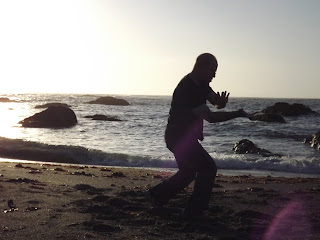This title sounds kind of obvious and lacks the excitement of another title meant to draw attention, but then again, Kenpo is not about fancy anything. It is about getting the job done. That is what I want to talk about. How do we get the job done? We work at it. Kenpo is not a fancy art, although I suppose it has the potential to be fancy if that is one's focus. It is an art that asks you to go to work every day and practice and not give up on your training. It is a part of daily life. Training must be made part of daily life so one can master it and, potentially save your life if it comes down to it.
How does one train in Kenpo? There are as many ways to train as there are people who practice it. It is up to the individual. It is an art of the individual. What one must do is follow the principles of Kenpo and his or her training will be sound. Kenpo is a set of rules that are designed to protect you if you follow them in the course of your martial arts training and performance. What are some of these principles? There are many.
Take, for example the inside rule. The inside rule states that you can disrupt a person's base and cancel their height zone. If you cancel their height zone, then most of their back-up weapons (open hand weapons) cannot be loaded because they are checked by the fact that your opponent cannot stand up straight.

Take the photo above. My wife, Gina, did a wonderful job of capturing me in the middle of Unfurling crane. If you are not familiar with this self-defense technique, this is a great example of Kenpo principles. This particular moment, you see the Kenpo principle of economy of motion in effect because I am doing three things, actually four things, at once. The leg is completing a front scoop kick, the hand in the middle of the picture is keeping the imaginary opponent standing upright for the soon-to-follow blow of the hand cocked and ready to deliver a chop to the neck, and the foot is not only completing the motion of the kick, it is loaded for a downward side thrust kick to the opposing knee. This technique is one of the more advanced in the Kenpo arsenal. What I described is centered on one motion of three parts of the body. This particular technique is based on multiple attacks and is placed fairly high in the web of knowledge that Mr. Parker designed.
But not everything has to be complex. Simplicity is at the heart of Kenpo. Complexity is what you choose to train if you like that. Sophistication lies in the movement based on the principles. I single move or concept can be more than enough.
Take the simple concept and definition of a check. A check, in Kenpo terms, is the nullification of a weapon. If you pin an opponent's arm to his or her body, then that weapon is nullified until you release it. What is important when executing principles is to follow the natural movements and guidelines of the human body. When when you use common sense and logic in figuring out the execution of your moves, then the principles of Kenpo will be largely followed. This simple act can, and often will, be enough to give you that advantage or just avoid the whole situation. Economy of motion is the key. Don't do more than you have to. If you check and cancel all of the opponent's weapons with one move, that might be enough to make them think twice and walk away. You never know, but economy of motion is key.
Unfurling Crane is a great example of Kenpo going to the extreme to show possible combinations. Every technique is about teaching the practitioner a variety of ideas and to get them thinking on possible ideas. Kenpo is a thinker's art, for sure. It is up to each of us to analyze and create the Kenpo that works for us. If you are an athlete and enjoy motion, take Kenpo, because it allows you the freedom to think on your own.
I know from talking with my sensei, Chuck Epperson, he wants us to think on our own. We need to train and practice our art. I start with the basics and try to always reinforce the basics and the principles. That is where everything comes from. There is a reason yellow belt is the foundation of all other belts that follow. If you look carefully at yellow belt, it is an extraordinary training ground for every practitioner to begin with. It is the start of the web of knowledge for Kenpoists. Next time you sit down to train, take another look at that opening belt. What is even more amazing, it is the first thing that everyone is taught!
I hope you enjoyed the article and enjoy training.
Jesse


